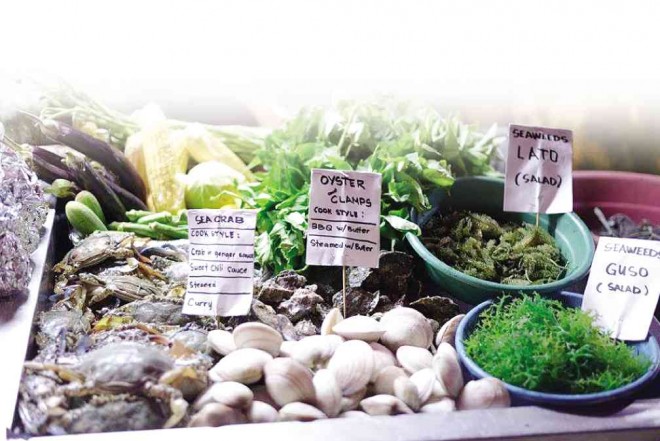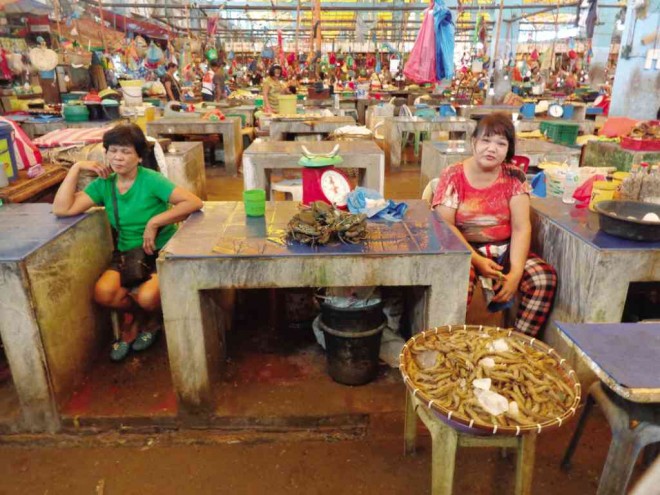Shellfish ban hurting Capiz, Bohol food tourism

SOME tourists are said to be scared of eating shellfish even if the ban is limited to Tagbilaran City and Dauis town in Bohol province. LEO UDTOHAN
Shellfish vendor Rochelle Bedico stared into empty space while sitting on her bare stall at the public market in Roxas City in Capiz province. Where will she now get money to feed her family, she thought.
Rainer Cargando, the market administrator of Teodoro Arcenas Trade Center, told Bedico and the other vendors not to sell any shellfish after the Bureau of Fisheries and Aquatic Resources (BFAR) issued a red tide warning on Aug. 29.
The stall holders have been hurting since the BFAR prohibited also the gathering and selling of shellfish due to the presence of red tide toxins in the seas off Roxas City and neighboring Panay town in Capiz, dubbed the Seafood Capital of the country.
Similar frustrations were felt in Tagbilaran City and Dauis town in Bohol province. The BFAR imposed the ban there as early as June 24 after five people fell ill from eating shellfish.
Red tide is a phenomenon where algae multiply rapidly and produce toxins harmful to wildlife and humans. The algae multiply faster when there are sudden changes in sea conditions, like temperature, salinity and the accumulation of organic load.
Article continues after this advertisementRed tide toxins, when ingested, can cause paralytic shellfish poisoning that could be fatal.
Article continues after this advertisementSapian Bay
In Capiz, the Sapian Bay, the main source of oysters and green mussels for Iloilo, Boracay Island and other areas in the country, has been found positive for red tide toxins. The bay spans the towns of Sapian and Ivisan, and Batan in neighboring Aklan province.
The toxicity level in the bay reached 74 microgram saxitoxin per 100 grams of shellfish meat, or higher than the regulatory limit of 60.
The “presence” of red tide toxin had also been reported in the waters off Roxas and nearby Panay, and is being closely monitored, said Sylvia dela Cruz, provincial agriculturist.
In Bohol, the shellfish ban has long been in effect in Tagbilaran and Dauis. It was issued by the BFAR on June 24 and was reiterated in its Aug. 29 advisory.
Aside from Dauis, BFAR Shellfish Bulletin 22 cautioned the public against eating shellfish, shrimp and crabs gathered or harvested from the Balite Bay in Mati City, Davao Oriental province, and the waters of Milagros in the Masbate area.

HILDA Cordovero (left) and Helen Clarito sell crabs and shrimp at the Teodoro Arcenas Trade Center in Roxas City, Capiz province, instead of shellfish following the red tide alert. Still, there are no takers. RALPH JOHN MIJARES
‘Yolanda’ survivors
Red tide has made it tough for Capiceños and Boholanos who are financially dependent on shellfish.
Families living in the coastal villages of Capiz have barely recovered from the onslaught of Supertyphoon “Yolanda” (international name: Haiyan) in 2013, but they are now reeling from loss of earnings to sustain their daily needs.
Bedico’s family is one of them. Her husband gathered shellfish which she would sell at Teodoro Arcenas Trade Center in Roxas.
Since the ban was enforced, the couple have not been earning anything. Bedico says she does not have money to put in another business, and has asked the help of relatives and friends to make both ends meet.
Also affected is the Cadimahan River Tour showcasing floating cottages for massage, manicure, pedicure and seafood delicacies in Sitio Lawis, Barangay Baybay, in the capital. Operated by 22 members of the Lawis Baybay Small Fisherfolk Association of Roxas City, the tour covers the barangays of Culasi, Libas, Dayao, Tanque and Baybay.
Earnings of the canteen, which serves mussels and oysters, have expected to plunge from P5,000 a day to P1,000. In one instance, it had no income at all, said Marianita Besana, reservation manager.
“Tourists usually come to Capiz, especially in Roxas City, for the seafood because it is affordable and delicious,” said Gov. Victor Tanco. “With the red tide advisory, there is no shellfish to sell and they will not come.”
Low sales
In Bohol, shellfish vendors in Tagbilaran are also complaining of low sales. Others have shuttered their stalls at Caingget Beach since only a few customers were coming.
Rosalina Gabi, 56, said customers were avoiding all shellfish dishes, including the “koja,” a coral clam found 3 to 6 meters deep. “The red tide has affected our livelihood. We don’t have koja to sell,” Gabi said.
She said she used to earn at least P600 on Saturdays and Sundays. The amount has dropped to P100.
Koja divers have shifted to fishing since they are not allowed to gather and sell koja, said Rodulfo Balite, 57. But they could not fish often due to rough seas, he added.
Eutorgio Telmo, Booy barangay chair, said he had helped some of the divers find jobs in construction projects.
Panglao tourists
On Panglao Island, home to popular beach resorts in Bohol, some tourists are scared of eating shellfish although the ban is limited to Tagbilaran and Dauis, said seafood vendor Patrick Manacpo, 18.
Some resorts offer seashells from Cebu province and other parts of Bohol, but there have been a few takers, he said. Panglao Mayor Leonila Paredes-Montero has stressed that seashells harvested from the town’s waters were safe to eat.
Leo Bongalos, acting chief of the BFAR in Bohol, asked the public to be “extra patient.”
“We will wait for the time until it is safe already,” Bongalos said.